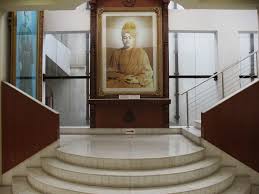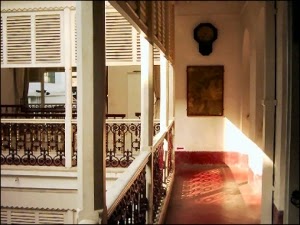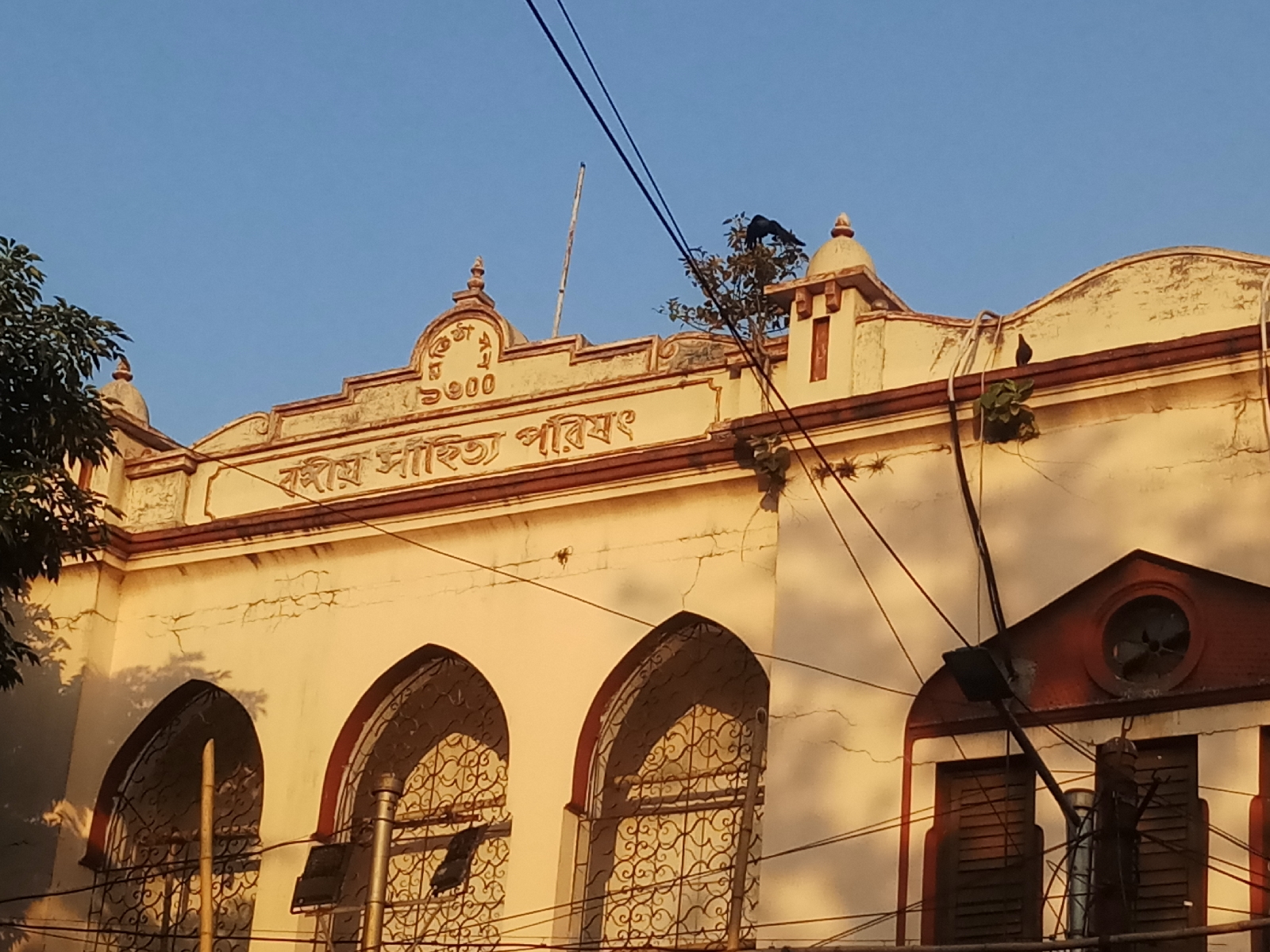- Just upon entering this historical building, we
were met with an interesting anecdote. Although named as Swami Vivekananda's
Ancestral House and Cultural Centre, it was the birthplace Narendranath Dutta.
Upon being initiated into the monk order, Swami Vivekananda did not spend a
single night here but came only to escort his mother to and from Calcutta High
Court during the ongoing legal dispute among the heirs.
 |
| The present building |
.jpg) |
| The Entrance |
.jpg) |
| Statue decorated on 12th January, Youth Day |
 |
| Upliftment of Mankind |
- At the entrance there is a
bookshop housing several books on the lives, works and gospels of The Holy
Trinity along with books on philosophy and self-improvement.
- The staircase on
either side of the life sized image of Swamiji seated in meditative posture
leads to the first floor.
.jpg) |
| Way to the first floor |
- Pictures of the contemporary landmarks of Kolkata are
displayed.
- Here one comes across tabloids depicting stories of Swamiji’s life.
A light and sound show on the origin of Vivekananda over ages depicts that
Swamiji was an incarnation of one of the Saptarishis (seven divine hermits) as
proclaimed by Ramakrishna Paramhansa.
- As one enters the inner portions of the
house, voice narratives enlighten the visitors about the illustrious Dutta
family. Originally residents of Delitone in Kalna, Sri Ramchandra Dutta along
with his sons migrated to and settled at the present day GPO area. From there
the family moved to Shimla (Sutanuti) and at 1756 relocated to the present
house at 3, Gour Mohan Mukherjee Street (a lane on Bidhan Sarani near Vivekanada
Road crossing).
- The elaborate family tree of the aristocratic family is
displayed here.
- Narendranath Dutta (Naren) was born on 12th January
1863 during the Makar Sankranti festival to Vishwanath Datta (an attorney at
the Calcutta High Court) Bhubaneswari Devi (a devout and pious housewife). The
birthplace of Naren was a makeshift bamboo shelter. This place is a permanent
structure now with a traditional wall clock set at the birth time of Naren.
 |
| Corridor leading to the birthplace |
.jpg) |
| Birthplace |
 |
| Verandah |
- The
place where Bhubaneswari Devi used to bathe Naren as a child taking Lord
Shiva’s name to pacify him is marked as well.
- The room where Narendranath’s
grandmother Raghumani Basu stayed is meticulously preserved along with a
replica of Ganga bhakti tarangini.
- Next, one passes to Narendranath’s
mother Shrimati Bhuvaneswari Devi’s room and the adjacent worship room where Lord
Vireswara Shiva’s replica by whose grace Narendranath was born to Bhuvaneswari
Devi is kept.
 |
| Room of Bhuvaneshwari Devi |
.jpg) |
| Worship room |
.jpg) |
| Grandmother's room |
 |
| Replica of Gangabhakti tarangini |
- A photo gallery beautifully showcases 40 photographs of
Swamiji taken at various parts of India and abroad.
- One is mesmerized and
awestruck by the huge canvas paintings done by Sri Sudhir Mohan Mirage, art
director (animation films), illustrator, painter, Mumbai. The paintings narrate
incidents of Vivekananda’s early days, Parliament of religion (1893), establishment
of Baranagar Math, gospels, and divine revelations.
- Other displays include the
room of Narendranath’s elder sister Swarnamoyee Devi (a student of Bethune
School), Viswanath Dutta (father), Mahendranath Dutta (younger brother),
Bhupendranath Dutta (younger brother and freedom fighter).
 |
| Father's study room witnessing Naren's silent crusade against untouchability |
 |
| The room where Naren's grandfather lived shortly after he renounced family life |
 |
| Elder brother's room |
.jpg) |
| The room where Sri Viswanath Dutta used to meet his clients |
- Musical instruments
and sports items used by Narendranath along with tabloids depicting incidents
of his life at the sprawling thakurdalan
are on exhibit as well.
.jpg) |
| Instruments used by Narandranath |
 |
| One of the life sized models depicting an incidence of Naren's spirituality at an young age |
- A special attraction is the 3D animation movie show on the Parliament of Religion, Chicago.
 |
| Before restoration |
.jpg) |
| The majestic courtyard after restoration |
- A separate room narrates the pictorially the
story of the restoration of the national pride, chronology of restoration events, events
during construction, inauguration, foundation day and notable visitors. The monumental decision for restoration of this building
was taken by the Government of West Bengal on the eve of the Narendranath’s
birth centenary in 1962. The dilapidated building housed as many as 143
families and small business centre. Land acquisition and restoration activities
began according to the plan of action laid by Ramkrishna Mission. Finally after
immense legal tussles and relocation of the inhabitants allover Kolkata the State
Government acquired the house and a few adjacent plots (on the northern side of
Gour Mohan Mukherjee Street) of land, and handed it to the Ramakrishna Mission
on 26th May 1999. The magnanimous restoration work
took five years for completion by skilled workmanship with the technical
assistance of the Archaeological Survey of India and the Development
Consultants Pvt. Ltd. The builders of the original structure were from Myanmar,
Mymensingha, Bankura, Uttarpara and Murshidabad. The
same or similar materials as used in the original 18thcentury
construction have been used and some of the original building materials are on display.
The original plan of the building was traced in the Archive of the High Court
of Kolkata. It helped to identify the later addition which had almost concealed
the original façade and interior. Notably, the Thakurdalan was concealed behind a
three-storeyed building that was added to it by the occupants. A brick by brick
removal of the added façade helped in locating its existence.
- The restored
ancestral house was proclaimed as a Heritage Building. The then
Vice-President, Swami Gahananandaji Maharaj, laid the foundation stone of the
proposed Ramakrishna Mission Swami Vivekananda Memorial and Cultural Centre on
10th March 2001.
The then General Secretary, Swami Smarananandaji inaugurated the newly built
Monks’ Quarters adjacent to the Heritage Building on 17th September
2004. On 26th September 2004, Revered Swami
Ranganathanandaji Maharaj, the 13th President
of the holy Order, officially opened the Ancestral House of Swami Vivekananda for
public viewing. On 1st October 2004, Dr. A P J Abdul kalam, the then
President of India, inaugurated the Cultural Complex adjacent to Swamiji’s
Ancestral House. Most Revered President Swami Atmasthanandaji Maharaj unveiled
the 12.5 ft bronze statue of Swami Vivekananda at this Centre on 1st
January 2008.
- The Cultural Centre holds classes for development of soft skills including language, computer and value education courses. Other activities undertaken by the Centre includes relief, educational, cultural, medical, spiritual and youth services.
References:
https://www.vivekanandahome.org/
https://mahendrajani.wordpress.com/tag/swami-vivekanandas-house/
All images taken from internet as photography and use of mobile phones is strictly prohibited within the premises
Date of visit: 29.04.2022 as a part of the Value and Ethics Certificate course for Undergraduate students of Bethune College

.jpg)
.jpg)

.jpg)

.jpg)


.jpg)
.jpg)




.jpg)
.jpg)


.jpg)



Comments
Post a Comment